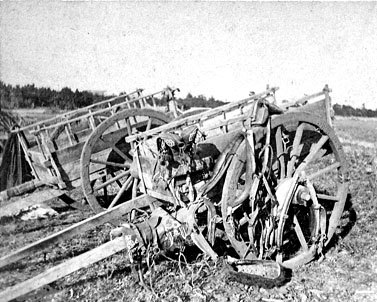Red River Carts

One of the earliest settlements by Europeans in the Red River Valley was at the north end of the river at Selkirk, north of Winnipeg (then Fort Garry). The nearest large city to the settlers was St. Paul, Minnesota.
According to the journal of North West Company fur-trader Alexander Henry (the younger), the carts made their first appearance in 1801 at Fort Pembina, just south of what is now the United States border. Originally the carts were small horse-drawn affairs, with three-foot solid wheels cut from large trees, carrying up to 450 pounds. Later, larger wheels with four spokes were used and gradually the red river carts with their huge, many-spoked wheels evolved, carrying nearly twice as much. Some had "tires" made of shaganappi (green rawhide).
In 1878 Harper's Magazine carried a description of the red river cart, written by reporters who visited the territory:
It is simply a light box with a pair of shafts, mounted on an axle connecting two enormous wheels. Ther is no concession made to the aversion of the human frame to sudden violent changes of level; there is no weakness of luxury about this vehicle. The wheels are broad in the felloes (rims), so as not to cut through the prairie sod. They are long in the spokes, so as to pass safely through fords and mudholes. They are very much dished so that they can be strapped together and rawhide stretched over them to make a boat. The whole cart is made of wood; there is not a bit of metal about it, so that, if anything breaks, the material to repair
it is easily found. The axles are never greased and they furnish an incessant answer to the old conundrum: "What makes more noise than a pig in a poke?"
Each wheel was said to have its own peculiar shriek, announcing the coming of a cart train from a great distance. (Grease or oil would have only mixed with the dust, wearing down the axles.) As it was, a cart often used four or five axles on the trip to St. Paul from the Red River settlement. Harness was made from a buffalo hide, often in one piece. Carts moved single file, except when in danger from Indians, when they traveled several abreast. Each driver controlled five or six carts strung out behind him, each ox tied to the cart ahead.
The carts were used to transport goods to as far away as St. Paul from Selkirk.
